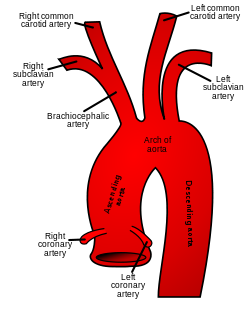
Back أبهر نازل Arabic Enən aorta Azerbaijani নিম্ন মহাধমনী Bengali/Bangla ތިރިއަށްފައިބާ އެއޯޓާ DV آئورت نزولی Persian Silazna aorta Croatian Aorta desendens ID Aorta discendente Italian 下行大動脈 Japanese 내림대동맥 Korean
| Descending aorta | |
|---|---|
 Plan of the branches. | |
 The thoracic aorta, viewed from the left side. | |
| Details | |
| Precursor | Dorsal aorta |
| Source | Ascending aorta |
| Branches | Thoracic aorta Abdominal aorta |
| Identifiers | |
| Latin | aorta descendens, pars descendens aortae |
| TA98 | A12.2.10.001 |
| TA2 | 4185 |
| FMA | 3784 |
| Anatomical terminology | |
In human anatomy, the descending aorta is part of the aorta, the largest artery in the body. The descending aorta begins at the aortic arch and runs down through the chest and abdomen. The descending aorta anatomically consists of two portions or segments, the thoracic and the abdominal aorta, in correspondence with the two great cavities of the trunk in which it is situated. Within the abdomen, the descending aorta branches into the two common iliac arteries which serve the pelvis and eventually legs.
The ductus arteriosus connects to the junction between the pulmonary artery and the descending aorta in foetal life. This artery later regresses as the ligamentum arteriosum.[1][2]
The descending aorta has important functions within the body. The descending aorta transports oxygenated blood from the heart to the rest of the body.[3]
- ^ Rubin, Raphael; Strayer, David S., eds. (2008). Rubin's Pathology: Clinicopathologic Foundations of Medicine (5th ed.). Philadelphia: Lippincott Williams & Wilkins. p. 442. ISBN 9780781795166.
- ^ Naidich, David P.; Webb, W. Richard; et al., eds. (2007). Computed Tomography and Magnetic Resonance of the Thorax (4th ed.). Philadelphia: Lippincott Williams & Wilkins. p. 100. ISBN 9780781757652.
- ^ "Aorta anatomy - UF Health". ufhealth.org. Retrieved 2024-12-06.